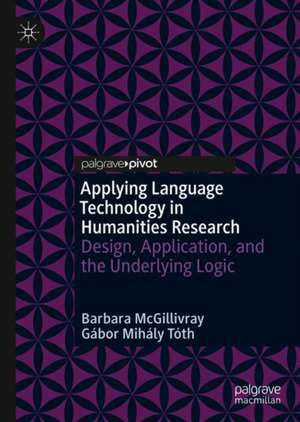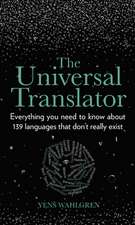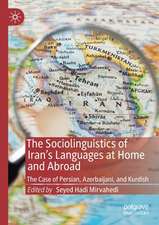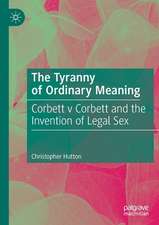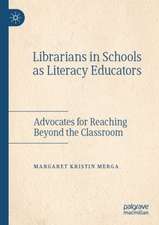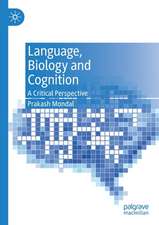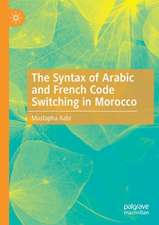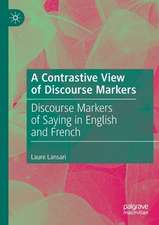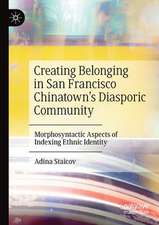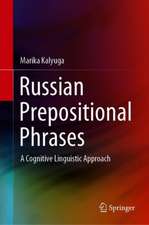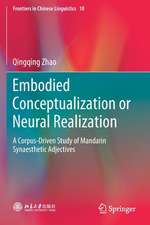Applying Language Technology in Humanities Research: Design, Application, and the Underlying Logic
Autor Barbara McGillivray, Gábor Mihály Tóthen Limba Engleză Hardback – 14 iul 2020
Preț: 483.70 lei
Nou
Puncte Express: 726
Preț estimativ în valută:
92.59€ • 100.60$ • 77.82£
92.59€ • 100.60$ • 77.82£
Carte tipărită la comandă
Livrare economică 21 aprilie-05 mai
Preluare comenzi: 021 569.72.76
Specificații
ISBN-13: 9783030464929
ISBN-10: 303046492X
Pagini: 85
Ilustrații: XIII, 126 p. 18 illus., 10 illus. in color.
Dimensiuni: 148 x 210 mm
Greutate: 0.32 kg
Ediția:1st ed. 2020
Editura: Springer International Publishing
Colecția Palgrave Macmillan
Locul publicării:Cham, Switzerland
ISBN-10: 303046492X
Pagini: 85
Ilustrații: XIII, 126 p. 18 illus., 10 illus. in color.
Dimensiuni: 148 x 210 mm
Greutate: 0.32 kg
Ediția:1st ed. 2020
Editura: Springer International Publishing
Colecția Palgrave Macmillan
Locul publicării:Cham, Switzerland
Cuprins
Chapter 1: Language Technology for the Humanities.- Chapter 2: Design of Text Resources and Tools.- Chapter 3: Frequency.- Chapter 4: Collocation.- Chapter 5: Word Meaning in Texts.- Chapter 6: Mining Textual Collections.- Chapter 7: Closing Remarks.
Notă biografică
Barbara McGillivray is a Turing Research Fellow at the University of Cambridge and The Alan Turing Institute, UK. She has published two monographs, Methods in Latin Computational Linguistics (2014) and Quantitative Historical Linguistics. A corpus framework (2017).
Gábor Mihály Tóth is a Research Fellow at the Shoah Foundation and the Signal Analysis and Interpretation Laboratory (SAIL), Viterbi School of Engineering, University of Southern California, USA.
Gábor Mihály Tóth is a Research Fellow at the Shoah Foundation and the Signal Analysis and Interpretation Laboratory (SAIL), Viterbi School of Engineering, University of Southern California, USA.
Textul de pe ultima copertă
“McGillivray and Tóth provide a very comprehensible introduction to the most important current approaches of computer-aided text analysis in the Digital Humanities. By giving illustrative examples and many practical tips, they let the reader participate in their vast experience in this quickly evolving field of research.”--Gregor Wiedemann, University of Hamburg, Germany
This book presents established and state-of-the-art methods in Language Technology (including text mining, corpus linguistics, computational linguistics, and natural language processing), and demonstrates how they can be applied by humanities scholars working with textual data. The landscape of humanities research has recently changed thanks to the proliferation of big data and large textual collections such as Google Books, Early English Books Online, and Project Gutenberg. These resources have yet to be fully explored by new generations of scholars, and the authors argue that Language Technology has a key role to play in the exploration of large-scale textual data. The authors use a series of illustrative examples from various humanistic disciplines (mainly but not exclusively from History, Classics, and Literary Studies) to demonstrate basic and more complex use-case scenarios. This book will be useful to graduate students and researchers in humanistic disciplines working with textual data, including History, Modern Languages, Literary studies, Classics, and Linguistics. This is also a very useful book for anyone teaching or learning Digital Humanities and interested in the basic concepts from computational linguistics, corpus linguistics, and natural language processing.
Barbara McGillivray is a Turing Research Fellow at the University of Cambridge and The Alan Turing Institute, UK. She has published two monographs, Methods in Latin Computational Linguistics (2014) and Quantitative Historical Linguistics. A corpus framework (2017).
Gábor Mihály Tóth is a Research Fellow at the USC Shoah Foundation and the Signal Analysis and Interpretation Laboratory (SAIL), Viterbi School of Engineering, University of Southern California, USA.
Gábor Mihály Tóth is a Research Fellow at the USC Shoah Foundation and the Signal Analysis and Interpretation Laboratory (SAIL), Viterbi School of Engineering, University of Southern California, USA.
Caracteristici
Sits at the intersection between Digital Humanities, Corpus Linguistics, Computational Linguistics, Natural Language Processing, and Text Mining Explores how qualitative research questions can be answered by Quantitative Text Analysis methods Fills a clear gap in the current state of art by bringing practice, theory and application together Questions how quantitative aspects of textual data uncovered through Quantitative Text Analysis can give rise to new research questions
